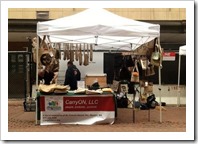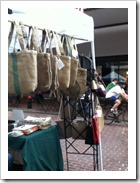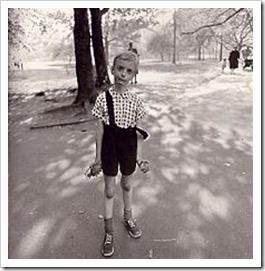This being National Candy month, my thoughts have quite naturally turned to candy, thoughts that quite naturally turn that way, given that I am a complete and utter sweet tooth. (Thanks, Dad! For that, and the long, skinny foot.)
Despite the fact that my father had a colossal sweet tooth, I did not grow up in Candy Land.
We had candy on Easter and Halloween, augmented by boxes of Candy Cupboard or Whitman Sampler that company would bring along at Thanksgiving or Christmas. And at school, they always gave us a red mesh stocking full of hard candies on the last day before Christmas vacation. But our house was mostly a No Candy Zone.
(My grandmother, on the other hand, always had candy around: Brach’s toffee, peanut brittle, or ribbon candy left over from Christmas that had gone all sticky – the ribbon candy, not the Christmas. Why Nanny would have hard-on-the-teeth candy around, given the state of her dentures, is beyond me. But a trip to Nanny’s always meant a piece of Brach’s toffee.)
Which is not to say that we didn’t have sweets galore. We always had ice cream in the freezer, and my mother baked pretty much every day.
And which is not to say that I wasn’t on occasion able to use some of my allowance on candy.
On one infamous occasion – when, for some reason, I had an entire quarter to squander – I bought five candy bars from the vending machine at the YWCA. And made myself sick. I was eight years old at the time, and while this was above and beyond the age of reason, I will blame my parents for this incident. After all, they had put me in temptation’s way by allowing me to step toe in a Y which, according to our nuns, was a Protestant organization no doubt hell bent on converting impressionable little Catholics to their nefarious false religion. Why, going to the Y was almost the equivalent of entering a Protestant church. So I was pretty much damned from the get go.
Despite the fact that I got sick, I remember how much fun it was to plunk those nickels in the machine and get instantly rewarded with a candy bar. Almost like getting a piece of cherry pie at the Automat, something that I fantasized doing from a very young age.
There are only two candys bar that I remembered from that spree: One was a packet of Charms – a candy I always loathed. The other, a ghastly Howard Johnson brand chocolate-covered something-or-other. (Vomit, maybe?) It was that Ho-Jo bar that put me over the line and into a near death experience. But what was behind the choice of Ho-Jo and Charms? Was the vending machine that lame-o, or was it the desire to experiment – with five options to play with, I could afford to have a couple of Fails.
Mostly, though, if I had candy money it was a couple of pennies or a nickel.
What did I buy with it?
Oh, back in the day I pretty much liked everything and anything: M&M’s, Charleston Chew, Bit-o-Honey, Sky Bars, Hershey Bars, Sugar Daddy/Sugar Babies, Good and Plenty, Junior Mints, Three Musketeers, Milky Ways, Juicy Fruits, Butterfingers, Baby Ruth. Necco Wafers if we were going to play Mass and needed them for Communion. Sometimes I bought a box of Canada Mints – I guess when I felt like eating chalk. I liked the little red box of Heide’s Chocolate Babies (sic: this was the 1950’s), and once I remember my Aunt Kay shared a box of Black Crows (sic: this was the 1950’s) with us out at the lake house. Sno-Caps and Raisenets? Strictly at the movie theater.
I still go for M&M’s – much my preferred main stream candy. And I also still like Good and Plenty, Butterfingers, and Junior Mints (the only candy that I actually prefer in the small size). And Twizzlers, I like Twizzlers. As for Bit-o-Honey,Juicy Fruits and Sugar Daddy/Sugar Babies – all those cavity-filling pullers - at my age, I’d just as soon gulp from a trough of quick-drying cement, since it would do the equivalent dental damage.
As a kid, I also liked cherry cough drops. (Still do.)
I discovered licorice all-sorts (the ones from England) on my first trip to NYC, senior year in high school. I suppose I was drawn to them because it was the only candy, other than Michigan Mints, that had blue. (This was before M&M’s foray into more color diversity. I like the blue, but I do wish they would bring back the traditional tan.) I still look at all-sorts longingly when I see them in the Vermont Country Store catalog.
And then there was penny candy…
My childhood coincided with the era when penny candy was actually penny candy, and our go-to spot for penny candy was Carrerra’s Market, a “spa” a couple of blocks away. (A “spa” being a tiny neighborhood store that sold bread, milk, Polar tonic (now known as soda), a few canned goods, and candy.)
Carrerra’s had big glass case full of penny candy just inside the door, and there was nothing better than having a couple of pennies – or even that precious nickel – to spend there.
Oh, the agony of choice. Mary Janes, Squirrel Nuts, wax lips, wax teeth, candy buttons, licorice whips, Frenchies (nougats), Mint Juleps (two for a penny), Banana Splits (ditto), candy cigarettes (those were the days!), Fire Balls, Tootsie Roll minis, York Peppermint Patties, and those little wax bottles full of colored sugar water.
Carrerra’s also sold a candy bar that I have never seen any place else: a chocolate Lunch Bar which, in the era of the fi ve-cent candy bar, cost a weird three cents. Even if you only had three cents, Lunch Bars were a chump’s game – they didn’t even taste remotely like chocolate. Perhaps it was that “emulsifier added” that did the nauseating trick. They were also the candy that the Carrerras gave out on Halloween.
ve-cent candy bar, cost a weird three cents. Even if you only had three cents, Lunch Bars were a chump’s game – they didn’t even taste remotely like chocolate. Perhaps it was that “emulsifier added” that did the nauseating trick. They were also the candy that the Carrerras gave out on Halloween.
Once in a while, generally when I’m in CVS and my sweet tooth gets a hankering, I’ll buy a bag of M&M’s (plain or peanut, maybe even the new-fangled coconut version). Or a Heath Bar or Butterfinger.
While the fundamental candy choices continue to apply, as time goes by, I have picked up some more sophisticated cravings – dark chocolate with orange, dark chocolate with sea salt, dark chocolate with anything. And I usually have some Lindt bars around, just in case I need a chocolate fix.
Which, of course, I do now.
All hail National Candy Month!
Liquor may be quicker, but candy is dandy!
 ossing (between the shell of Filene’s which – hallelujah! – is at long last a construction site, and Macy’s a.k.a. the ghost of Jordan Marsh past).
ossing (between the shell of Filene’s which – hallelujah! – is at long last a construction site, and Macy’s a.k.a. the ghost of Jordan Marsh past). 







